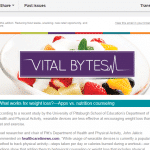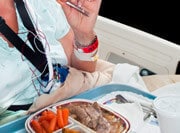As seniors enter long-term care and senior living communities at increasingly younger ages, the social aspect of dining becomes more important, as well as the quality and presentation of the food. In the coming year, there are key trends that will continue to have a major influence on dining Read More >>
How Hospital’s Upped Their Game in 2016
In looking back at the year that just passed, it's clear that the landscape of health care foodservice is changing. Hospitals are expanding services to provide more options to employees and visitors who patronize retail food sales outlets. Exciting options like food trucks, Read More >>
Healthcare Foodservice Checkup
In a recent survey, over 200 foodservice operators and one thousand consumers were surveyed about the priorities, perceptions, and needs of patients, staff, visitors, residents and the ways health care operators play a unique role in foodservice. In recent years, food has come to play a Read More >>
Vital Bytes Newsletter – March 2017
Vision Software is the leading provider of health care web-based food service solutions in the world. We are passionate about our mission: helping you to make a difference in the lives of the patients and customers in your care through excellence in food service informatics and extraordinary Read More >>
Healthcare Food Trends for 2017
Each new year brings advancements in the food service industry that have the potential to revolutionize the way health care food service providers feed patients, employees, and visitors who come to their facilities. Among the growing trends for 2017 are investments in equipment and personnel that Read More >>
Survey: Patient Needs, Preferences Drive Health Care Food Service Programs
In a recent survey conducted by Datassentials, over 200 healthcare operators and 1,000 consumers shared their opinions and experiences with food service in health care facilities and discussed the choices and challenges faced by both food service operators and the patients, customers and visitors Read More >>
Educating Patients on Nutrition
Patient education is a key aspect of any treatment plan. This is especially important when talking about nutrition. According to the National Institutes of Health, as many as 40% of admitted patients are suffering from some form of malnutrition. Giving patients the information and Read More >>
Hospitals Strive to Change Lives through Changing Food Service Fare
There's a growing trend among hospital food service operations that is focused on changing the way patients, employees and visitors eat every day. As the nature of care moves from treatment to prevention, health care professionals stress the importance of starting by offering better Read More >>
Better Nutritional Standards for Meals
Hospitals in the United States spend billions of dollars each year treating diet-related chronic illness. By improving nutritional intervention during admissions, hospitals have an opportunity, and increasingly, an obligation, to improve the long-term nutritional status of patients and prevent Read More >>
Boost HCAHPS Scores with Vision Software
The Hospital Consumer Assessment of Healthcare Providers and Systems (HCAHPS) survey establishes a national standard for collecting or publicly reporting patients' perspectives on care that would enable valid comparisons to be made across all hospitals. The survey is designed to produce comparable Read More >>
















